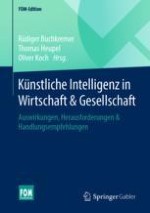2020 | OriginalPaper | Chapter
15. Die Anwendung von Machine Learning zur Gewinnung von Erkenntnissen aus Dokumentenstapeln
Author : Stefan Ebener
Published in: Künstliche Intelligenz in Wirtschaft & Gesellschaft
Publisher: Springer Fachmedien Wiesbaden
Activate our intelligent search to find suitable subject content or patents.
Select sections of text to find matching patents with Artificial Intelligence. powered by
Select sections of text to find additional relevant content using AI-assisted search. powered by
